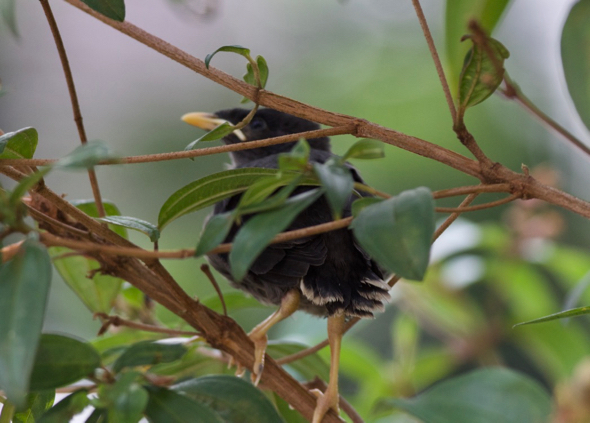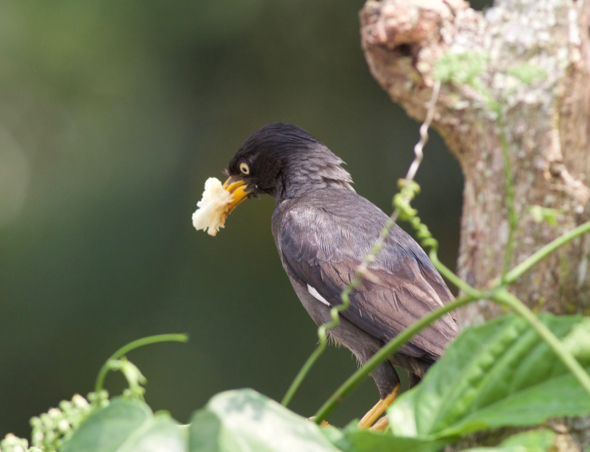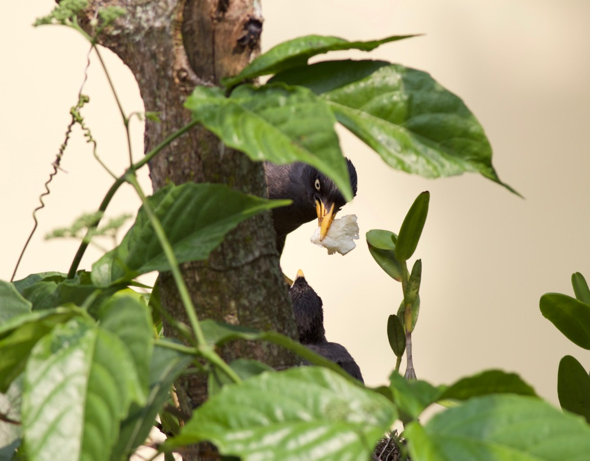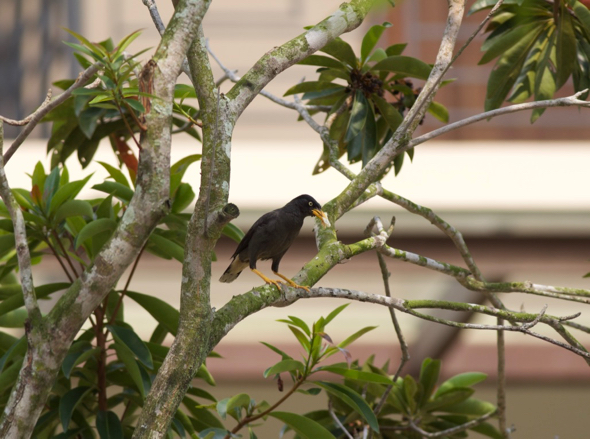On the morning of 4th October 2017, when I was working on my compost heap, a blue eggshell dropped at my feet LINK. Looking up I saw a Javan Myna (Acridotheres javanicus) standing at the edge of my roof. So, a pair of Javan Mynas nesting nearby must have just hatched an egg.
I have a resident pair of mynas that regularly forages nearby whenever I work on my garden. Can it be that their nest was nearby and an egg had just hatched? A few days later when I was turning up the compost, the mynas managed to catch an earthworm or two and flew off. Suddenly I heard the chirpings of chicks when food is delivered to them. The sound came from the roof of my back-neighbour’s house. So I was right, my resident mynas were nesting again.
On the afternoon of 25th October 2017 I heard the begging cries of a juvenile Javan Myna in my front garden (above). Obviously, the chick, hatched from the egg on 4th October, had just fledged. So, the fledging period (meaning the number of days from hatching to fledging) of the Javan Myna is 21 days. This bit of information has not been reported before (see Craig & Feare, 2009; Feare & Craig, 1998; Wells, 2007) but we know the incubation period as 13-14 days.
An adult was seen responding to the begging cries of a juvenile perched on a branch of the Singapore Rhododendron (Melastoma malabathricum) bush in my garden. Later that evening there was an attempt at feeding the begging juvenile but without success (above, below). The adult had a beak-full of food but apparently the juvenile had yet to learn how to accept the adult’s offer of food outside the nest. The latter did not know it had to open its beak to receive the food.
As I was trying to photograph both birds, the adult was moving around the juvenile, even flying to a nearby tree and back. It took some time before the juvenile finally accepted the food. It moved to the ground to eat it, then returning to its perch. This must have been an early learning period after leaving the nest.
The next morning the juvenile was again found in the same bush begging for food. It has yet to accompany the adults foraging on the ground, a scene I had seen many times before.
Towards dusk two adults arrived with food and then lured the juvenile to a nearby tree. The juvenile then flew back to the bush, followed by the adults. I would assume that the adults were trying without success to get the juvenile to fly to their usual roosting area as they subsequently flew off (see video below). The juvenile spent the night on a branch of the bush. I was not able to locate the juvenile the next morning. It had most probably flew off with the adults.
That evening I again heard the begging cries of the juvenile. This time it was on a palm at the back of my garden. Later the cries were heard in the front of my garden, coming from a roadside tree. The juvenile must have improved its flying skills and now moving around with the adults. However, the adults still brought food to it and have yet to teach it to forage on the ground.
Summary of breeding schedule:
1. Days from egg laying to hatching = 13-14 days (Craig & Feare, 2009; Feare & Craig, 1998; Wells, 2007).
2. Days for chick to fledge = 21 days.
3. Number of days for fledgling to become independent of the adults = estimated as 25 days, needs confirmation LINK.
YC Wee
Singapore
28th October 2017
References:
1. Craig, A. J. F. K. & C. J. Feare, 2009. Family Sturnidae (Starlings). In: del Hoyo, J., A. Elliott & D. A. Christie (eds.). Handbook of the birds of the world. Vol. 14. Bush-shrikes to Old World Sparrows. Lynx Editions, Barcelona. Pp. 654-758.
2. Feare, C. & A. Craig, 1998. Starlings and mynas. Christopher Helm (Publishers) Ltd., London. 285 pp.
3. Wells, D.R., 2007. The birds of the Thai-Malay Peninsular. Vol. II, Passerines. Christopher Helm, London. 800 pp.













3 Responses
It’s a pretty demanding schedule, being parents!
Thanks for making more new discoveries about my favourite bird species! Indeed, people in Singapore rarely notice Javan Mynas, most people seem to pretend that they aren’t there. Most of my friends don’t even know about the name of this bird!
Yes, I fully agree with you.